Alaska Fish & Wildlife News
February 2025
Bear and Moose Awareness in the City
Decades of Wildlife Safety in Anchorage Schools
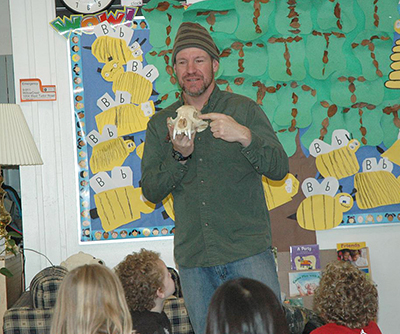
Home to just under 300,000 people, Anchorage, Alaska is every bit a city as any other. It’s a place where one can visit fine art galleries, go neon bowling at the mall, and seldom be more than a couple miles away from a Big Mac.
Yet despite the city’s undeniable urban character, for many that live and work in Anchorage there is another crucial quality that keeps it from simply being “Anywhere, USA”: the reality of wild things and wild places that butt up against the city’s backyard and even within its borders.
The Municipality of Anchorage, stretching from Eklutna to Portage, is home to several hundred black bears and many hundreds of moose, not to mention a few dozen brown bears. Dall’s sheep can be found clinging to the cliffs south of town, while all five species of Pacific salmon struggle up the city’s waterways to spawn. Foxes, otters, and beavers make their living within the city’s limits and lynx, wolves, and wolverines roam the city’s outskirts and even occasionally through its greenbelts.
It is largely because of this incredible abundance and diversity of native animal life – truly unique among American cities – that when searching for a new slogan for Alaska’s metropolis in 2007, the former Anchorage Convention and Visitors Bureau settled on “Big. Wild. Life.”
But sharing your city and neighborhood with big, wild lifeforms can come with challenges. Bears and moose in particular are large, powerful animals and run-ins always carry with them the potential for human harm. Knowledge of how to respond appropriately during a bear or moose encounter and how to properly manage wildlife attractants such as garbage and birdseed can be crucial for coexistence, but how best to ensure that such knowledge is being shared with members of the community?
Birth of a Program

In 2002, ADF&G’s newly formed Wildlife Education Program sought to answer this question. Recognizing that an informed populace is essential for the safety of both people and wildlife, the program set out to provide wildlife safety messaging to the public in a more formalized manner than had been previously possible.
Lilly Goodman-Allwright served as ADF&G’s first Wildlife Education Specialist for the Anchorage area, a position she held from 2002-2005. Prior to her employment with the Department, requests from local schools or community groups for wildlife safety presentations largely fell on whichever Anchorage staff members had the time and interest. While area biologists were passionate about teaching students how to be safe around wildlife, Goodman-Allwright recalls that this was often unfeasible given their other duties.
Recognizing the community need for safety presentations in schools, but with duties of her own and education responsibilities for a region including such far-flung communities as Glennallen, Dillingham, and Kodiak, she took a novel approach to meet demand: she created a volunteer educator program.
Under Goodman-Allwright’s leadership, volunteer educators traveled to schools once a week to deliver wildlife safety presentations to multiple individual classrooms. This program was still in effect when Elizabeth Manning took over the role of Anchorage area educator in 2006 and was even expanded under her direction to include outreach to anglers regarding proper fishing etiquette in bear country.
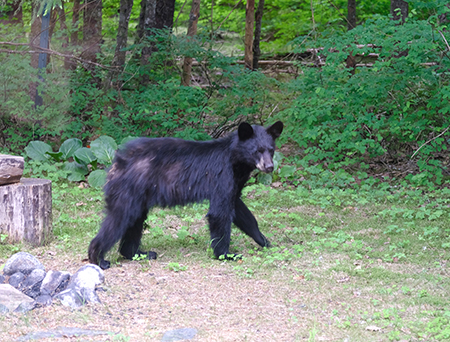
But while successful, the volunteer educator program was not without its challenges. Volunteers took time to train, and since they were not employees, scheduling could become complicated with the ever-increasing interest from local teachers in classroom safety talks. Volunteer turnover was another issue, and Manning began to wonder if perhaps the department needed a dedicated wildlife safety instructor.
2008 marked a year of unusually high bear-human conflict in Anchorage, culminating in three separate incidents that resulted in human injury. This, in combination with the increasing demand for classroom wildlife safety programs, led to the decision that the department’s wildlife safety efforts needed to expand and gave Manning the justification she needed to begin searching for a dedicated ADF&G wildlife safety instructor.
Finding the right person for the job was easier said than done, however. Many experienced wildlife experts weren’t necessarily the best fit for a job dealing less with animals and more with children, and finding educators possessing first-hand familiarity with bear and moose behavior proved difficult.
But as luck would have it, there was a person with all the necessary qualities already within the department.
Anchorage Wildlife Safety Finds its Face
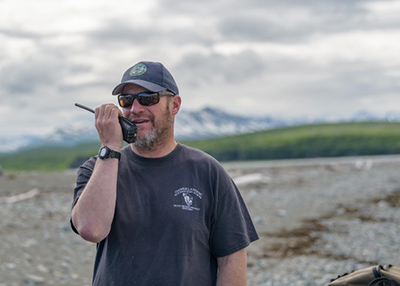
Tom Griffin is in many ways the ideal wildlife educator. Soft-spoken and modest, yet with a calm, confident manner, he is the sort of person that students and adults alike find themselves eager to listen to.
An early background as a summer camp counselor and public school paraprofessional, combined with 23 years living and working among the world’s largest congregation of brown bears at McNeil River State Game Sanctuary (14 years serving as sanctuary manager, a position he still holds today) gives Griffin a uniquely qualified distinction as both capable instructor and authority on how to live safely with wildlife.
These qualifications were not lost on Elizabeth Manning. Upon visiting McNeil in 2008 and serendipitously speaking with Griffin’s former supervisor Larry Aumiller (who was serving as a volunteer staff substitute), Manning recognized Griffin as the perfect candidate for teaching wildlife safety in schools.
“Larry’s the one who got me the job,” Griffin will note humbly, though Manning is quick to point out that just as much as Aumiller’s recommendation, it was Griffin’s extensive first-hand bear experience and ability to convey information in a way both engaging and instructive that made him an obvious choice.
The arrangement worked out well for everyone; the wildlife education program gained a knowledgeable and enthusiastic presenter dedicated solely to teaching wildlife safety, and Griffin picked up another month or so of department employment that supplemented his four-month summer field season.
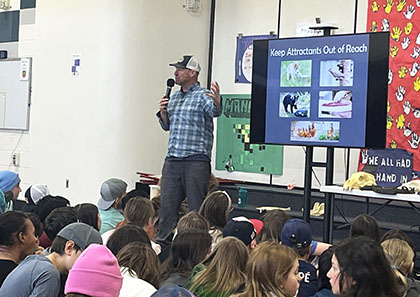
In the early years, presentations looked much as they had in the volunteer days: Griffin would visit individual classrooms, and through a combination of props, activities, and drawings on the classroom whiteboard convey to students the dos and don’ts of bear and moose safety. But as word spread and demand for presentations grew, it became apparent that classroom presentations were not meeting the community’s needs.
“In the early days I would often end up losing my voice,” Griffin recalls, “I would be doing five, sometimes six classroom programs in a day, so we began reaching out to principals to see if we could bring all of the first grade or second grade classes into the multi-purpose room to present to entire grade levels at once. From there came the realization that the presentations could really be condensed into one for K-2 students and one for 3-6, and the two-assemblies-per-school format became much more manageable. I think the quality of the programming improved because now I could dedicate all of my energy to one or two assemblies, and I think that doing this allowed the messaging to be better conveyed and received.”
Changing technologies drove the direction of the program as much as community demand. Whereas presentations in the early days had relied on wildlife artifacts and whiteboard illustrations, students and teachers alike have become more tech-savvy and tech-expectant. The assemblies have correspondingly evolved to include PowerPoint presentations and high-quality video clips played on large screens.
One thing that hasn’t changed, however, is Griffin’s conviction that by teaching youth proper bear and moose etiquette, wildlife safety messaging is being spread far and wide throughout the community. “Kids learn something at school, and they go home and are like the police,” Griffin jokes, “they start to look for bear attractants around their house – garbage, dog food, greasy grills - and start talking to their family about best practices for managing those attractants.”
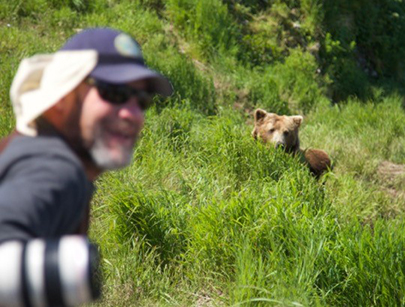
“It’s my personal hope that by using a positive approach - not using fear-based learning to make students afraid of wildlife or going outside - we can empower them to know what to do to be safer outdoors and develop good wildlife safety instincts that they can carry with them into adulthood.”
“Mr. Tom’s” Legacy
That students take Griffin’s teachings to heart is obvious when hearing testimonials from teachers and school administrators.
Laura Roark of Anchorage Montessori School recalls, “The children always love Tom’s visits and one thing that stands out is that last year, the day after his presentations we had an agitated cow moose and her calf run past the window of one of the early childhood classrooms followed by a bull moose. The children ran to the window and discussions ensued on what Tom had taught them the day before about how to tell when a moose is agitated. It was a beautiful and well-timed lesson that those children will never forget. We laughed that Tom sent us the moose to go along with his presentation!”

Similar stories can be heard again and again, which is easy to understand as over the years Griffin has become a perennial facet of many schools’ assembly lineups and is known affectionately as “Mr. Tom” to an entire generation of Anchorage schoolchildren.
In recent years, Griffin’s “teaching season” has grown to encompass the entire spring semester and has expanded beyond the Anchorage area to include Kenai Peninsula schools as well, bringing the safety messaging already shared with thousands to an even wider audience (last year alone Griffin reached over 16,000 students and community members throughout Southcentral Alaska).
Through it all, Griffin has always maintained his characteristic work ethic and can-do attitude.
“Tom is like the Energizer Bunny,” Manning laughs, “he was always up for presentations and could just go, go, go. He’s a very skilled presenter and has a gift for connecting with an audience. It was always obvious that he understood the importance of the program, and while he always took the work seriously, he was able to have fun with it at the same time. He was always professional and always smiling, which made him a joy to work with.”
Though Manning left her position with ADF&G in 2018, her successors and other staff who have worked alongside Griffin all mirror her sentiment.
When asked to reflect on his contributions to the program, Griffin is quick to instead shift focus to the opportunities that the program has provided him.
“I’ve just been really fortunate to have this position,” he notes, “I’ve always found it fun to talk to the public, and being an educator and getting to share your experience in such a way to empower others and celebrate being outdoors doing the things you yourself like to do is so rewarding. Anchorage has such diversity, and it’s really been an honor to see and meet all these different components of our community – public schools, homeschool groups, parochial schools, libraries, retirement homes. Who else gets that insight?”
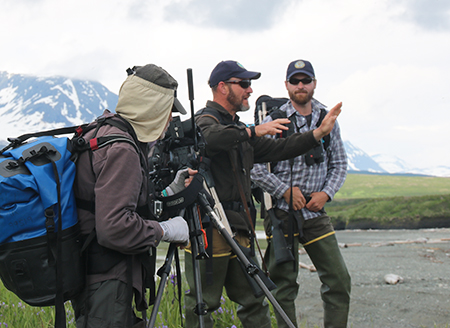
2024 marked Tom’s 16th year teaching wildlife safety in Anchorage schools and was also the year in which he decided it was time to pass the torch.
While the Anchorage wildlife safety program will certainly miss Tom dearly, the program itself shows no sign of slowing down, with presentation demand as high as ever and new staff members stepping up to fill the large shoes left behind.
If you are interested in scheduling a wildlife safety presentation for your Anchorage-area school or community program, please follow the link below and department staff will get in contact with you shortly: Sign Up for Bear and Moose Safety Presentations, Alaska Department of Fish and Game
More on bear safety and videos of Tom providing tips on bear awareness, bear encounters, and using bear spray.
Subscribe to be notified about new issues
Receive a monthly notice about new issues and articles.
